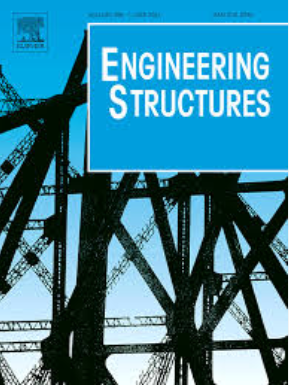Breaking boundaries: discontinuum failure analysis of dry-joint masonry using physics engine models
IF 6.4
1区 工程技术
Q1 ENGINEERING, CIVIL
引用次数: 0
Abstract
Discontinuum approaches, including the Distinct Element Method (DEM), are well-established for simulating the failure of dry-joint unreinforced masonry (URM) structures, particularly under in-plane (IP) shear-compression and out-of-plane (OOP) loading. However, they may be computationally intensive, with building-scale DEM analyses requiring up to 3 days for 15 s of seismic loading. This paper breaks boundaries between structural engineering and computer science by presenting the first systematic evaluation of PyBullet, an open-source physics engine based on Bullet Physics – originally conceived for visually plausible virtual animations – for simulating the mechanical response and collapse of dry-joint URM assemblies at different scales. Leveraging PyBullet’s rigid body algorithms, contact models, and efficient constraint solvers, 3D simulations were performed for IP shear-compression walls, settlement-induced damage in interlocking panels, and OOP tilting of URM. Results were benchmarked against experimental data and established discontinuum models – PyBullet predicted peak loads within + 16 % of DEM for IP shear-compression walls. Numerical stability was maintained with time steps in the order of 0.001 s, and full simulations completed within 5 min – up to 6 times faster than DEM. OOP tilting analyses reproduced expected collapse modes (diagonal cracking, overturning) with critical collapse angles underestimated by up to 32 %, largely due to premature block slippage linked to contact stiffness and friction force coupling. Settlement-induced failure in interlocking panels showed good agreement with experimentally observed failure patterns, with ultimate displacements within ±3 % for non-interlocking cases. The study demonstrates that PyBullet offers a computationally efficient alternative for dry-joint URM analysis, providing reduced runtimes and acceptable predictive accuracy, especially for preliminary or large-scale probabilistic assessments. Further refinement of contact stiffness calibration strategies would enhance predictive consistency, supporting the adoption of physics engines as viable alternatives to conventional discontinuum methods for rapid masonry collapse and debris simulations.
突破边界:用物理引擎模型分析干缝砌体的非连续破坏
包括离散元法(DEM)在内的非连续介质方法已被广泛用于模拟干缝无筋砌体(URM)结构的破坏,特别是在面内(IP)剪切压缩和面外(OOP)荷载作用下。然而,它们可能需要大量的计算,对于15 s的地震载荷,建筑规模的DEM分析需要长达3天的时间。本文打破了结构工程和计算机科学之间的界限,提出了PyBullet的第一个系统评估,PyBullet是一个基于Bullet physics的开源物理引擎,最初是为视觉上合理的虚拟动画而设计的,用于模拟不同规模的干关节URM组件的机械响应和崩溃。利用PyBullet的刚体算法、接触模型和高效约束求解器,对IP剪切压缩墙、联锁面板中沉降引起的损伤和URM的OOP倾斜进行了3D模拟。结果以实验数据和建立的非连续体模型为基准——PyBullet预测的峰值荷载在IP剪切压缩墙DEM的+ 16 %范围内。时间步长为0.001 s,保持了数值稳定性,完整模拟在5 min内完成,比DEM快6倍。OOP倾斜分析再现了预期的坍塌模式(对角开裂、倾覆),临界坍塌角度被低估了高达32% %,主要是由于与接触刚度和摩擦力耦合相关的过早块体滑移。联锁面板的沉降引起的破坏与实验观察到的破坏模式非常吻合,在非联锁情况下,最终位移在±3 %内。该研究表明,PyBullet为干关节URM分析提供了一种计算效率高的替代方案,提供了更少的运行时间和可接受的预测准确性,特别是对于初步或大规模的概率评估。进一步完善接触刚度校准策略将提高预测的一致性,支持采用物理引擎作为传统非连续体方法的可行替代方案,用于快速砌体倒塌和碎片模拟。
本文章由计算机程序翻译,如有差异,请以英文原文为准。
求助全文
约1分钟内获得全文
求助全文
来源期刊

Engineering Structures
工程技术-工程:土木
CiteScore
10.20
自引率
14.50%
发文量
1385
审稿时长
67 days
期刊介绍:
Engineering Structures provides a forum for a broad blend of scientific and technical papers to reflect the evolving needs of the structural engineering and structural mechanics communities. Particularly welcome are contributions dealing with applications of structural engineering and mechanics principles in all areas of technology. The journal aspires to a broad and integrated coverage of the effects of dynamic loadings and of the modelling techniques whereby the structural response to these loadings may be computed.
The scope of Engineering Structures encompasses, but is not restricted to, the following areas: infrastructure engineering; earthquake engineering; structure-fluid-soil interaction; wind engineering; fire engineering; blast engineering; structural reliability/stability; life assessment/integrity; structural health monitoring; multi-hazard engineering; structural dynamics; optimization; expert systems; experimental modelling; performance-based design; multiscale analysis; value engineering.
Topics of interest include: tall buildings; innovative structures; environmentally responsive structures; bridges; stadiums; commercial and public buildings; transmission towers; television and telecommunication masts; foldable structures; cooling towers; plates and shells; suspension structures; protective structures; smart structures; nuclear reactors; dams; pressure vessels; pipelines; tunnels.
Engineering Structures also publishes review articles, short communications and discussions, book reviews, and a diary on international events related to any aspect of structural engineering.
 求助内容:
求助内容: 应助结果提醒方式:
应助结果提醒方式:


